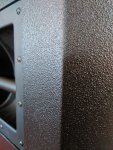Thanks Kevin, Jeff, and Peter for your most generous and valuable advice.
As is obvious, phase correction is completely new to me so I appreciate your advice immensely. All the systems mentioned in Jeff's link are sadly outside my budget, with the exception of miniDSP. My system will be 5-way and I am planning to use - please don't laugh - a Behringer DEQ2496 feeding two DCX2496 via AES. Can phase be corrected at the input to the DEQ using a miniDSP or is phase correction intrinsic to the crossover filters?
Thanks all, Carl.
As is obvious, phase correction is completely new to me so I appreciate your advice immensely. All the systems mentioned in Jeff's link are sadly outside my budget, with the exception of miniDSP. My system will be 5-way and I am planning to use - please don't laugh - a Behringer DEQ2496 feeding two DCX2496 via AES. Can phase be corrected at the input to the DEQ using a miniDSP or is phase correction intrinsic to the crossover filters?
Thanks all, Carl.











